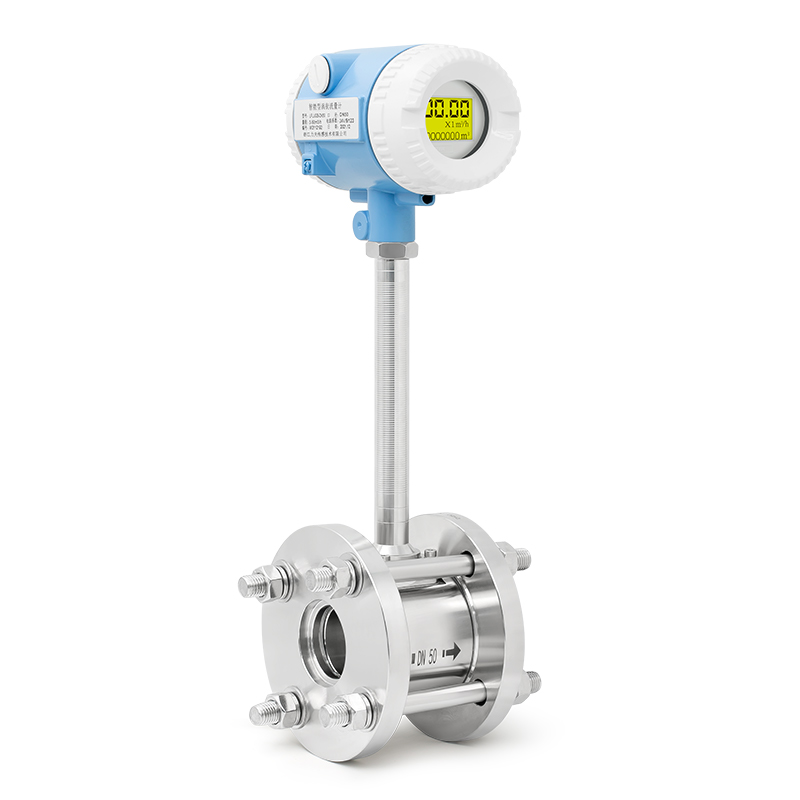Transmisor
The vortex flowmeter is an instrument that places a bluff vortex generator in the fluid, and the fluid is alternately separated on both sides of the generator to release two series of regularly staggered vortices.
Vortex flowmeter can be divided into: stress type, strain type, capacitive type, thermal type, vibrating body type, photoelectric type and ultrasonic type according to the frequency detection method.
Vortex flowmeter is the youngest type of flowmeter, but it has developed rapidly and has now become a common type of flowmeter.
The temperature and pressure compensation function is also integrated in the meter body, which can measure the standard volume flow or standard mass flow of the fluid.
Fully intelligent and digital circuit design can automatically compensate the density of the measured fluid or calculate the volume under standard conditions.
New digital filtering and correction functions make flow measurement more accurate and reliable.
The battery-powered type can work continuously for more than two years without external power supply.
The new dot matrix Chinese character LCD display is more convenient to use and operate.
Measuring medium: liquid, gas, steam Nominal diameter: DN15-DN300 (non-standard products can be customized according to user requirements) Temperature range: -40℃~350℃ Pressure specification: PN1.6Mpa; PN2.5Mpa; PN4.0Mpa, Higher pressure specifications can be customized. Range: normal range 1:10, extended range 1:15 Indication ±2.5% supply voltage: sensor +12VDC, +24VDC (optional) transmitter +24VDC.
On-site display type The instrument comes with a 3.6 lithium battery output signal: sensor pulse frequency signal 0.1~3000Hz low level ≤ 1V high level ≥ 6V.
Transmitter two-wire 4~20mADC current signal allowable vibration acceleration: Piezoelectric ≤0.2g Ambient temperature: -40℃~55℃ (non-explosion-proof place) -20℃~55℃ (explosion-proof place) Humidity 5~85% Signal long-distance transmission distance: ≤500m Signal line interface: Internal thread M20×1.5 Explosion-proof grade: iaⅡCT2-T5 1Cr18Ni9Ti, special materials can also be used according to user requirements.
The application of vortex flowmeter flow measurement technology and instruments generally has the following fields.
Flow meter is one of the major types of process automation instruments and devices. It is widely used in metallurgy, electric power, coal, chemical industry, petroleum, transportation, construction, textile, food, medicine [7], agriculture, environmental protection and People's daily life and other fields of the national economy are important tools for developing industrial and agricultural production, saving energy, improving product quality, and improving economic efficiency and management level, occupying an important position in the national economy. In process automation instruments and devices, flow meters have two major functions: as a detection instrument for process automation control systems and a total meter for measuring the quantity of materials.
Energy is divided into primary energy (coal, crude oil, coalbed methane, petroleum gas and natural gas), secondary energy (electricity, coke, artificial gas, refined oil, liquefied petroleum gas, steam) and energy-carrying working fluid (compressed air, oxygen, nitrogen, hydrogen, water), etc. Energy metering is an important means of scientifically managing energy, realizing energy saving and reducing consumption, and improving economic benefits. Flow meters are an important part of energy measuring instruments. Water, artificial gas, natural gas, steam, and oil products all use a huge number of flow meters, which are indispensable tools for energy management and economic accounting.
The discharge of flue gas, waste liquid, sewage, etc. seriously pollutes the atmosphere and water resources, and seriously threatens the living environment of human beings. The country regards sustainable development as a national policy, and environmental protection will be the biggest issue in the 21st century. To control air and water pollution, management must be strengthened, and management is based on quantitative control of the amount of pollution.
my country is a country where coal is the main energy source, and there are millions of chimneys in the country that continuously emit flue gas into the atmosphere. Flue gas emission control is an important project to eradicate pollution. Each chimney must be equipped with flue gas analysis instruments and flow meters to form a continuous emission monitoring system. There are many difficulties in the flow rate of flue gas. The difficulty is that the size of the chimney is large and the shape is irregular, the gas composition is variable, the flow velocity range is large, dirt, dust, corrosion, high temperature, no straight pipe section, etc.
There are five ways: railway, air, water, and pipeline transportation. Among them, although pipeline transportation has already existed, its application is not universal. With the prominence of environmental protection issues, the characteristics of pipeline transportation have attracted people's attention. Pipeline transportation must be equipped with flow meters, which are the eyes of control, distribution and scheduling, and an essential tool for safety monitoring and economic accounting.
The flowmeter has certain requirements on the upstream and downstream straight pipe sections at the installation point, otherwise it will affect the measurement accuracy.
1. The sensor should be installed on a horizontal, vertical, inclined (liquid flow from bottom to top) pipe with the same diameter. The upstream and downstream of the sensor should be equipped with straight pipe sections of a certain length.
2. The nearby pipeline where the liquid sensor is installed should be filled with the liquid to be measured.
3. The sensor should be avoided to be installed on the pipeline with strong mechanical vibration.
4. The inner diameter of the straight pipe section should be consistent with the sensor diameter as much as possible. If it cannot be consistent, a pipe slightly larger than the sensor diameter should be used, and the error should be ≤3% and not more than 5mm.
5. The sensor should be avoided to be installed in places with strong electromagnetic field interference, small space and inconvenient maintenance.
22 Oct 2023
Entrar en el futuro: la evolución de las bombas peristálticas de motor paso a paso14 Oct 2023
Manipulación innovadora de fluidos: el viaje de la bomba peristáltica del motor paso a paso hacia la precisión06 Oct 2023
Control de precisión y fluidos: revelar la potencia de la bomba peristáltica del motor paso a paso24 Sep 2023
Aprovechar la innovación: el futuro del tratamiento de agua con bombas purificadoras de aguaConsulta de productos
 English
English  français
français  Deutsch
Deutsch  Español
Español  italiano
italiano  русский
русский  português
português  العربية
العربية  Türkçe
Türkçe  Zulu
Zulu 
